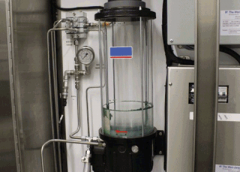An intelligent automated grease-dispensing system (AGS) developed by Weir-Jones Engineering of Vancouver, B.C., Canada, significantly reduces operational and maintenance costs and lowers the potential for human error in operations that deploy submerged pumps or equipment requiring regular lubrication that must be remotely verified.
The AGS was developed in 2013 for use in the tailings ponds by a multinational operator in an Alberta oil sands mining operation. It is capable of supplying bearing and sealing greases to pumps located under 200 ft. of water.
The system is ideal for the quarry, dredging, and oil and gas sector plus other industries that operate under extreme conditions where remotely operated equipment must be regularly maintained and its maintenance status confirmed.
In addition to submersible pumps, AGS provides automated lubrication for equipment located in inaccessible or hazardous locations. This includes material handling equipment and conveyor transfer points and equipment in pipeline compressor stations.
“AGS units can be used wherever an owner wants to remove human interaction or where it is very costly to shut down an operation for repairs or maintenance,” said Weir-Jones Engineering President Iain Weir-Jones.
“If we were to compare using a Weir-Jones AGS to manning the pumps 24/7, it is estimated that use of an AGS would save an operator, after capital costs have been recovered, at least $300,000 a year,” said Weir-Jones. “And a single AGS unit would pay for itself the moment a human operator missed one greasing time, did not inject enough grease, or did something else grease-related that causes a pump to fail while submerged in 200 ft. of water.”
The Weir-Jones AGS is a user-friendly configurable dispensing unit capable of supplying bearing and sealing greases to submerged pumps at pressures of up to 300 bar and down line lengths of 200 ft. The AGS is designed to manage dispense frequency and start/stop timing internally and to report status over a standard communications link.
The units can be customized to suit specific machine application and will maintain a continuous record of system health and dispense data. Multiple units can be connected together using a central lubricant supply or they can be fed semi-automatically from a standard barrel. Typical refill intervals will vary based upon usage but one to six months would be normal.
Weir-Jones Engineering, www.weir-jones.com

